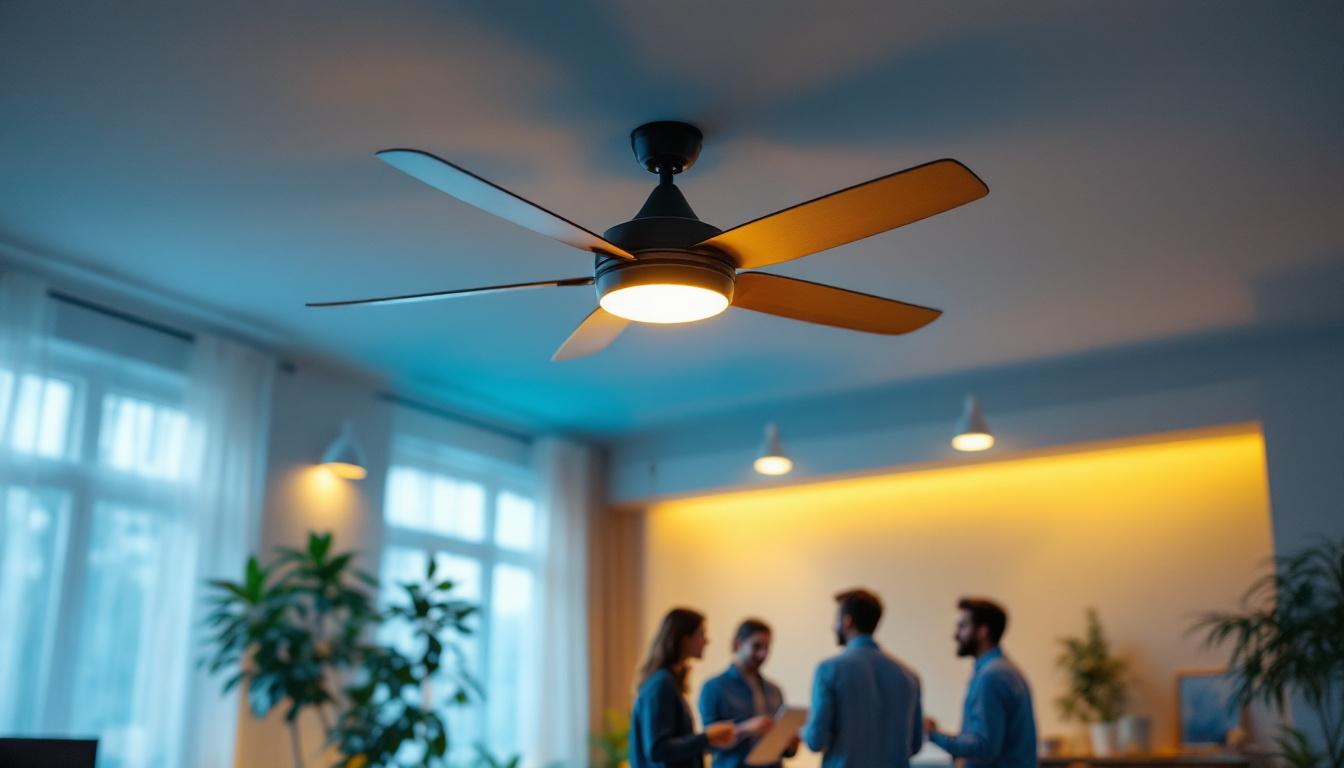
In the world of interior design, lighting plays a crucial role in establishing ambiance and functionality. For lighting contractors, understanding how to effectively train their teams in lighting design is essential for delivering exceptional results. This article explores the importance of training, the various aspects of lighting design, and how to integrate elegant ceiling fans into your lighting strategy.
Training is a vital component in the skill development of any team, especially in a field as nuanced as lighting design. A well-trained team not only enhances the quality of work but also boosts client satisfaction and fosters a culture of continuous improvement.
Lighting design encompasses a wide range of technical skills, including an understanding of light sources, color temperature, and the interplay between light and space. Training should focus on these technical aspects to ensure that team members are well-versed in the latest technologies and trends.
Workshops and hands-on training sessions can be particularly effective. By allowing team members to experiment with different lighting setups, they can gain practical experience that theoretical learning alone cannot provide. This hands-on approach helps solidify their understanding of how to manipulate light to achieve desired effects. Additionally, incorporating software training for design tools, such as CAD and 3D modeling programs, can further enhance their technical capabilities. Familiarity with these tools allows designers to visualize their concepts more effectively and communicate their ideas with precision.
Effective communication is key in understanding and meeting client needs. Training should include modules on client interaction, emphasizing the importance of listening and asking the right questions. This enables team members to tailor lighting solutions that align with the client’s vision and requirements.
Role-playing exercises can be beneficial in this regard. By simulating client meetings, team members can practice articulating their ideas and responding to client feedback. This not only builds confidence but also enhances their ability to provide personalized service. Furthermore, understanding the broader context of a client’s project—such as their brand identity, target audience, and overall design aesthetic—can significantly improve the relevance and impact of the lighting solutions proposed. Training sessions that include case studies of past projects can illustrate how effective communication and understanding client needs have led to successful outcomes, providing valuable lessons for team members.
A comprehensive understanding of lighting design involves several key aspects. Each component contributes to the overall effectiveness of a lighting project, and training should address these elements thoroughly.
There are three primary types of lighting: ambient, task, and accent. Each serves a distinct purpose and should be utilized strategically within a space. Ambient lighting provides overall illumination, task lighting focuses on specific areas for activities, and accent lighting highlights particular features or objects.
Training sessions should cover the characteristics and applications of each type of lighting. Team members should learn how to assess a space and determine the appropriate balance of these lighting types to enhance both aesthetics and functionality. For example, in a kitchen, ambient lighting can create a warm and welcoming environment, while task lighting over countertops ensures safety and efficiency during food preparation. Accent lighting, such as under-cabinet lights, can draw attention to decorative elements or artwork, adding depth and interest to the design.
Color temperature, measured in Kelvin, significantly affects the mood of a space. Warm light (below 3000K) creates a cozy atmosphere, while cool light (above 4000K) is often associated with productivity and focus. Understanding these nuances is crucial for creating the desired ambiance.
Training should also address light quality, including factors such as brightness, color rendering index (CRI), and glare. By educating team members on these elements, they can make informed decisions about the selection of light fixtures and bulbs that best suit the intended purpose of each space. For instance, a high CRI is essential in settings like art galleries or retail stores, where accurate color representation is vital. Moreover, understanding how to minimize glare through proper fixture placement and shade design can enhance comfort and usability, ensuring that spaces are not only visually appealing but also functional and inviting.
Ceiling fans are not just functional devices; they can also serve as elegant design elements that enhance the overall aesthetic of a space. Training your team to incorporate ceiling fans into their lighting designs can set your services apart from competitors. By recognizing the dual role of ceiling fans, designers can create harmonious environments that are both stylish and comfortable, making the most of every room’s potential.
When selecting ceiling fans, it is essential to consider both style and functionality. Factors such as blade size, motor efficiency, and design aesthetics should all be taken into account. Training should include guidance on how to evaluate these factors to recommend the best options to clients. For instance, larger spaces may benefit from fans with longer blades to ensure adequate airflow, while smaller rooms might require compact designs that do not overwhelm the space.
Additionally, team members should be educated on the various styles of ceiling fans available, from modern and sleek designs to more traditional looks. Understanding the architectural style of a space will help them make informed recommendations that align with the client’s vision. It’s also beneficial to discuss the importance of color and finish, as these elements can dramatically influence the overall look of a room. A brushed nickel fan might complement a contemporary space, while a rustic wooden fan could enhance a cozy, farmhouse-style interior.
Many modern ceiling fans come equipped with integrated lighting options. Training should cover how to effectively incorporate these features into a lighting design. Team members should learn how to position fans to optimize both airflow and light distribution, ensuring that the space is well-lit and comfortable. This involves understanding the different types of bulbs available, such as LED or incandescent, and how each type can affect the ambiance of a room.
Moreover, understanding the electrical requirements and installation processes for ceiling fans with integrated lighting is crucial. This knowledge will enable team members to provide accurate information to clients about installation timelines and any potential electrical upgrades that may be necessary. Additionally, it’s important to discuss the benefits of smart ceiling fans, which can be controlled via mobile apps or voice commands, offering clients convenience and energy efficiency. By staying informed about the latest technology in ceiling fans, your team can better cater to the evolving needs of modern homeowners, ensuring that every project is not only aesthetically pleasing but also functional and up-to-date with current trends.
Effective training requires a blend of theoretical knowledge and practical application. Implementing a variety of training techniques can enhance engagement and retention among team members.
Hands-on workshops are an excellent way to reinforce learning. By allowing team members to experiment with different lighting setups and ceiling fan installations, they can gain valuable experience that builds confidence and competence.
Consider organizing field trips to completed projects or showrooms where team members can observe and analyze real-world applications of lighting design. This exposure can inspire creativity and deepen their understanding of how to apply their training in practical situations.
In today’s digital age, online learning platforms offer a wealth of resources that can supplement traditional training methods. Consider curating a list of reputable online courses, webinars, and tutorials that focus on lighting design and ceiling fan integration.
Encouraging team members to engage with these resources can promote continuous learning and keep them updated on industry trends and innovations. Regularly scheduled discussions about newly acquired knowledge can further enhance team cohesion and knowledge sharing.
To ensure that training efforts yield positive results, it is essential to measure their effectiveness. This can be achieved through various methods that assess both knowledge retention and application in the field.
Soliciting feedback from team members after training sessions can provide valuable insights into what worked well and what areas may need improvement. Additionally, conducting assessments or quizzes can help gauge understanding and retention of key concepts.
Implementing a mentorship program where experienced team members guide newer staff can also facilitate knowledge transfer and reinforce learning. This approach fosters a collaborative environment and encourages ongoing skill development.
Ultimately, the success of training can be measured through client satisfaction. Gathering feedback from clients about their experiences and the quality of lighting designs can provide a clear indicator of how well the team has applied their training.
Regularly reviewing client feedback and making adjustments to training programs based on this information can lead to continuous improvement and enhanced service delivery.
Training your team in lighting design is an investment that pays dividends in the form of enhanced skills, improved client satisfaction, and a competitive edge in the market. By focusing on the key aspects of lighting design, integrating elegant ceiling fans, and employing effective training techniques, lighting contractors can elevate their services to new heights.
As the industry continues to evolve, staying informed and adaptable is crucial. Embracing a culture of continuous learning and improvement will not only benefit your team but also ensure that clients receive the highest quality of service and design.
Incorporating elegant ceiling fans into your lighting strategy can also set your business apart, adding both aesthetic value and functionality to your projects. With the right training and resources, your team can master the art of lighting design, creating spaces that are both beautiful and practical.
Ready to enhance your lighting designs and give your clients the exceptional quality they deserve? Look no further than LumenWholesale for all your lighting needs. Our spec-grade lighting products set the standard for excellence, providing you with the reliability and performance necessary for any project. Say goodbye to unnecessary markups and hello to value with our unbeatable wholesale prices, complete with the convenience of free shipping on bulk orders. Elevate your lighting game and discover the ideal fusion of quality, affordability, and ease. Start browsing our selection today and take the first step towards brighter, more beautiful spaces at the best value. Wholesale Lighting at the Best Value.

Discover essential insights for lighting contractors on selecting and installing parking lot lights and poles.

Discover expert insights into LED lighting for patios with answers to common questions from lighting contractors.

Discover how Envision Led is transforming lighting solutions with innovative technology.

Discover the latest trend in lighting design with car-shaped light bulbs! This article offers expert advice for lighting contractors on how to incorporate these unique bulbs into projects, enhancing aesthetics and client satisfaction.